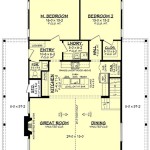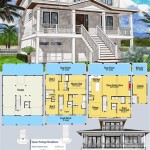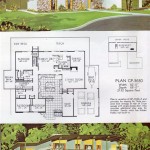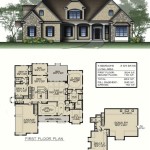Mountain Home Plans for Sloping Lots: Design Considerations and Benefits
Building a home on a sloping lot presents unique architectural challenges and opportunities. Mountainous regions, known for their dramatic landscapes, often require specialized home plans that effectively integrate with the natural terrain. Mountain home plans designed for sloping lots must address issues related to stability, accessibility, drainage, and aesthetics, while maximizing the views and embracing the surrounding environment. A successful integration of design and site minimizes environmental impact and creates a harmonious living space.
Choosing the right mountain home plan for a sloping lot requires careful consideration of several factors. The degree of the slope, soil conditions, local building codes, and personal preferences all play a crucial role in determining the most suitable design. Standard house plans are often inadequate for sloping terrain and may require significant modifications, adding unexpected costs and compromises. Custom-designed plans, while potentially more expensive initially, offer the advantage of being tailored specifically to the site and the homeowner's needs, resulting in a more efficient and satisfying outcome.
The architectural style of the home should also complement the mountain setting. Rustic designs, incorporating natural materials like wood, stone, and timber, blend seamlessly with the environment. Contemporary designs, with clean lines and large windows, can offer stunning panoramic views while maintaining a modern aesthetic. Ultimately, the choice of style is a matter of personal taste, but it is essential to consider how the design will integrate with the surrounding landscape.
Understanding Slope and Site Analysis
Before selecting a mountain home plan for a sloping lot, a thorough site analysis is essential. This involves evaluating the degree of the slope, the direction of the slope, the soil composition, and the presence of any natural features such as rock outcroppings, trees, or watercourses. A geotechnical survey may be necessary to determine the stability of the soil and identify any potential hazards, such as landslides or erosion. The results of the site analysis will inform the design process and help determine the most appropriate foundation type and construction techniques.
The degree of the slope is a critical factor in determining the feasibility of building on the lot. Steeper slopes may require more extensive excavation and retaining walls, increasing construction costs. Gentler slopes offer more flexibility in design and may allow for a more conventional foundation. The direction of the slope also affects solar orientation, which can influence the placement of windows and outdoor living spaces. A south-facing slope, for example, will receive more sunlight during the winter months, while a north-facing slope may be cooler and shadier.
Soil composition is another important consideration. Sandy soils drain well but may be unstable, while clay soils retain water and can expand and contract, potentially causing foundation problems. Rocky soils can be difficult to excavate but may provide a solid base for construction. Understanding the properties of the soil will help determine the appropriate foundation type and drainage system. A well-designed drainage system is crucial for preventing water damage and erosion on a sloping lot.
The presence of natural features can also influence the design. Existing trees, for example, can provide shade and privacy, but their root systems may interfere with construction. Rock outcroppings can be incorporated into the design to create unique landscaping features. Watercourses must be carefully managed to prevent flooding and erosion. Protecting and preserving the natural environment should be a priority in any mountain home construction project.
Foundation Options for Sloping Lots
The foundation is the most critical element of any home, especially one built on a sloping lot. The foundation must be strong and stable enough to support the weight of the house and withstand the forces of gravity, wind, and earthquakes. There are several foundation options available for sloping lots, each with its own advantages and disadvantages. The choice of foundation will depend on the degree of the slope, the soil conditions, and the overall design of the home.
One common option is a walkout basement. This type of foundation is built into the slope, creating a lower level that is partially or fully exposed on one side. Walkout basements provide extra living space, storage, or recreational areas. They also offer easy access to the outdoors and can be used as workshops or home offices. The cost of a walkout basement is typically higher than a conventional slab foundation, but the added living space and functionality can make it a worthwhile investment.
Another option is a stepped foundation. This type of foundation is built in a series of steps, following the contour of the slope. Stepped foundations are commonly used on moderately sloping lots and can be adapted to a variety of architectural styles. They are typically less expensive than walkout basements, but they may require more excavation and retaining walls. Stepped foundations can also create interesting architectural features, such as tiered gardens or outdoor living spaces.
Pier and beam foundations are another option, particularly for steep slopes or unstable soil conditions. This type of foundation consists of a series of concrete or steel piers that are driven deep into the ground, supporting a network of beams. Pier and beam foundations are more expensive than other foundation types, but they offer superior stability and can be used on almost any type of terrain. They also allow for better drainage and ventilation under the house, reducing the risk of moisture problems.
Crawl spaces are a less expensive alternative. They raise the house and allow access to plumbing and electrical systems. This option might require insulation to prevent heat loss and moisture buildup.
Design Strategies for Integrating with the Landscape
Successfully integrating a mountain home with a sloping lot requires careful attention to design details. The goal is to create a home that feels like a natural extension of the landscape, rather than an imposition on it. This can be achieved through the use of natural materials, thoughtful site planning, and innovative architectural solutions. The design should also minimize the environmental impact of the construction process and preserve the natural beauty of the surrounding area.
One effective strategy is to use terracing to create level areas for outdoor living spaces. Terraces can be built using retaining walls, stone walls, or natural slopes. They provide comfortable areas for patios, gardens, and decks, and they can also help to prevent erosion. Terraces can also be used to create visual interest and add depth to the landscape.
Another strategy is to incorporate natural materials into the design. Wood, stone, and timber blend seamlessly with the mountain environment and create a warm and inviting atmosphere. These materials can be used for siding, roofing, decks, and landscaping features. Using locally sourced materials can also help to reduce the environmental impact of the construction process and support local economies.
Orienting the house to maximize views and solar gain is also important. Large windows and open floor plans can provide stunning panoramic views of the surrounding mountains. South-facing windows can capture sunlight during the winter months, helping to heat the house naturally. Overhangs and awnings can provide shade during the summer months, reducing the need for air conditioning. Strategic placement of windows and doors can also improve natural ventilation and reduce energy consumption.
Minimizing the footprint of the house is another way to reduce the environmental impact. Smaller houses require less excavation and grading, and they consume less energy. Consider designing a compact and efficient floor plan that makes the most of the available space. Using sustainable building practices, such as energy-efficient appliances, water-saving fixtures, and renewable energy sources, can further reduce the environmental impact of the home.
Landscaping is also crucial. Native plants require less water and maintenance, and they provide habitat for local wildlife. Consider planting trees to provide shade and privacy, and to help stabilize the soil. Avoid using invasive species that can harm the native ecosystem. A well-designed landscape can enhance the beauty of the home and blend it seamlessly with the surrounding environment.
Building on a sloping lot offers the opportunity to create a unique and beautiful home that is perfectly suited to its environment. By carefully considering the challenges and opportunities presented by the site, and by working with experienced architects and builders, one can create a mountain home that is both functional and aesthetically pleasing.

Plan 68753vr Mid Century Modern Mountain House For Rear Sloped Lot Plans

Mountain Modern Steep Slope Hillside House Sloping Lot Plan

Taos Ridge Mountain Home Plans From House

100 Best Sloping Lot House Plan Ideas Design Hillside

Looking For The Perfect Affordable Cottage With A Large Covered Balcony Plan 1143

A Guide To Sloping Lot House Plans

Hillside And Sloped Lot House Plans

Best Simple Sloped Lot House Plans And Hillside Cottage

Hillside House Plans For A Rustic 3 Bedroom Mountain Home

Hillside House Plans Architecturalhouseplans Com








